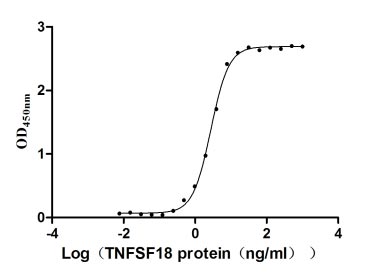Recombinant Clostridioides difficile Toxin B (toxB), partial
-
货号:CSB-YP321589DUN
-
规格:
-
来源:Yeast
-
其他:
-
货号:CSB-EP321589DUN
-
规格:
-
来源:E.coli
-
其他:
-
货号:CSB-EP321589DUN-B
-
规格:
-
来源:E.coli
-
共轭:Avi-tag Biotinylated
E. coli biotin ligase (BirA) is highly specific in covalently attaching biotin to the 15 amino acid AviTag peptide. This recombinant protein was biotinylated in vivo by AviTag-BirA technology, which method is BriA catalyzes amide linkage between the biotin and the specific lysine of the AviTag.
-
其他:
-
货号:CSB-BP321589DUN
-
规格:
-
来源:Baculovirus
-
其他:
-
货号:CSB-MP321589DUN
-
规格:
-
来源:Mammalian cell
-
其他:
产品详情
-
纯度:>85% (SDS-PAGE)
-
基因名:toxB
-
Uniprot No.:
-
别名:toxB; tcdB; Toxin B; EC 3.4.22.-
-
种属:Clostridium difficile
-
蛋白长度:Partial
-
蛋白标签:Tag type will be determined during the manufacturing process.
The tag type will be determined during production process. If you have specified tag type, please tell us and we will develop the specified tag preferentially. -
产品提供形式:Lyophilized powder
Note: We will preferentially ship the format that we have in stock, however, if you have any special requirement for the format, please remark your requirement when placing the order, we will prepare according to your demand. -
复溶:We recommend that this vial be briefly centrifuged prior to opening to bring the contents to the bottom. Please reconstitute protein in deionized sterile water to a concentration of 0.1-1.0 mg/mL.We recommend to add 5-50% of glycerol (final concentration) and aliquot for long-term storage at -20℃/-80℃. Our default final concentration of glycerol is 50%. Customers could use it as reference.
-
储存条件:Store at -20°C/-80°C upon receipt, aliquoting is necessary for mutiple use. Avoid repeated freeze-thaw cycles.
-
保质期:The shelf life is related to many factors, storage state, buffer ingredients, storage temperature and the stability of the protein itself.
Generally, the shelf life of liquid form is 6 months at -20°C/-80°C. The shelf life of lyophilized form is 12 months at -20°C/-80°C. -
货期:Delivery time may differ from different purchasing way or location, please kindly consult your local distributors for specific delivery time.Note: All of our proteins are default shipped with normal blue ice packs, if you request to ship with dry ice, please communicate with us in advance and extra fees will be charged.
-
注意事项:Repeated freezing and thawing is not recommended. Store working aliquots at 4°C for up to one week.
-
Datasheet :Please contact us to get it.
相关产品
靶点详情
-
功能:Precursor of a cytotoxin that targets and disrupts the colonic epithelium, inducing the host inflammatory and innate immune responses and resulting in diarrhea and pseudomembranous colitis. TcdB constitutes the main toxin that mediates the pathology of C.difficile infection, an opportunistic pathogen that colonizes the colon when the normal gut microbiome is disrupted. Compared to TcdA, TcdB is more virulent and more important for inducing the host inflammatory and innate immune responses. This form constitutes the precursor of the toxin: it enters into host cells and mediates autoprocessing to release the active toxin (Glucosyltransferase TcdB) into the host cytosol. Targets colonic epithelia by binding to the frizzled receptors FZD1, FZD2 and FZD7, and enters host cells via clathrin-mediated endocytosis. Frizzled receptors constitute the major host receptors in the colonic epithelium, but other receptors, such as CSPG4 or NECTIN3/PVRL3, have been identified. Binding to carbohydrates and sulfated glycosaminoglycans on host cells suface also contribute to entry into cells. Once entered into host cells, acidification in the endosome promotes the membrane insertion of the translocation region and formation of a pore, leading to translocation of the GT44 and peptidase C80 domains across the endosomal membrane. This activates the peptidase C80 domain and autocatalytic processing, releasing the N-terminal part (Glucosyltransferase TcdB), which constitutes the active part of the toxin, in the cytosol.; Active form of the toxin, which is released into the host cytosol following autoprocessing and inactivates small GTPases. Acts by mediating monoglucosylation of small GTPases of the Rho family (Rac1, RhoA, RhoB, RhoC, RhoG and Cdc42) in host cells at the conserved threonine residue located in the switch I region ('Thr-37/35'), using UDP-alpha-D-glucose as the sugar donor. Monoglucosylation of host small GTPases completely prevents the recognition of the downstream effector, blocking the GTPases in their inactive form, leading to actin cytoskeleton disruption and cell death, resulting in the loss of colonic epithelial barrier function.
-
基因功能参考文献:
- The high susceptibility of enteric glial cell to toxin B in vitro, the increased sensitivity to inflammatory cytokines related to apoptosis and the persistence of altered functions in surviving cells suggest an important in vivo role of enteric glial cell in the pathogenesis of C. difficile infection. PMID: 27891552
-
亚细胞定位:[Toxin B]: Secreted. Host endosome membrane.; [Glucosyltransferase TcdB]: Host cytoplasm, host cytosol. Host cell membrane; Peripheral membrane protein; Cytoplasmic side.
Most popular with customers
-
Recombinant Human Tumor necrosis factor ligand superfamily member 18 (TNFSF18), partial (Active)
Express system: Mammalian cell
Species: Homo sapiens (Human)
-
Recombinant Human G-protein coupled receptor family C group 5 member D (GPRC5D)-VLPs (Active)
Express system: Mammalian cell
Species: Homo sapiens (Human)
-
Recombinant Mouse Complement component C1q receptor (Cd93), partial (Active)
Express system: Mammalian cell
Species: Mus musculus (Mouse)
-
Express system: Mammalian cell
Species: Homo sapiens (Human)
-
Recombinant Macaca fascicularis Trophoblast glycoprotein (TPBG), partial (Active)
Express system: Mammalian cell
Species: Macaca fascicularis (Crab-eating macaque) (Cynomolgus monkey)
-
Recombinant Human Dickkopf-related protein 1 (DKK1) (Active)
Express system: Mammalian cell
Species: Homo sapiens (Human)
-
Recombinant Human C-type lectin domain family 4 member C (CLEC4C), partial (Active)
Express system: Mammalian cell
Species: Homo sapiens (Human)
-
Recombinant Human Myosin regulatory light chain 12A (MYL12A) (Active)
Express system: E.coli
Species: Homo sapiens (Human)







-AC1.jpg)












